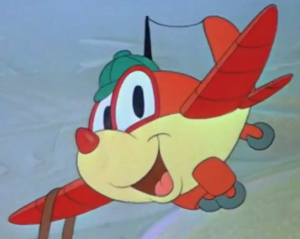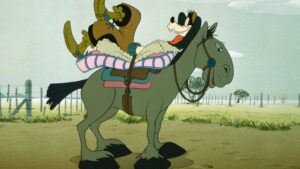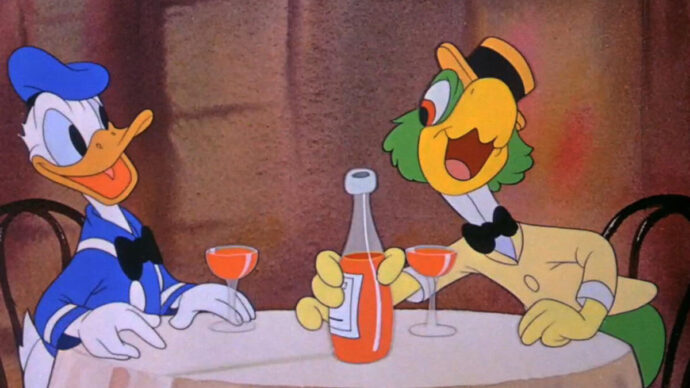Plus or Minus is a series detailing and analyzing every feature film now streaming on Disney+. It combines the unique history all these films share, their cultural impacts, and their qualities, or lack thereof. From timeless classics, to acquired hits, to DCOMs, no stone will be left unturned.
Throughout this series, it’s been pretty easy to talk about every movie. However, this Plus or Minus edition, focusing on 1943’s Saludos Amigos, is a tricky one. Not because the movie itself is hard to talk about. Rather, it’s barely even a movie. At 42 minutes, it only just passes as a feature-length film. And at first glance, the premise seems barebones. Essentially, Disney artists travel to Latin America, explore different locations, and develop cartoons based around their experiences. And…that’s it. True, there’s four different shorts here, but that’s all we’re given. To the average Disney+ subscriber, this project seems bizarre. Who are these animators? How was this considered film-worthy material? Why did this get made?
To truly understand Saludos Amigos is to look at its history. In fact, its history is more interesting than the film itself.
The War
Similar to COVID-19, World War II decimated The Walt Disney Company. Pinocchio and Bambi were box office flops because overseas markets were closed down. Many of Disney’s animators were drafted. Money was getting tight, and there weren’t enough people to get the job done. Therefore, the little money Disney made at that point were propaganda pieces. Cheap cartoons promoted by the government to help rally the citizens and cry out support to the men on the battlefield.
And Saludos Amigos was solely made as a piece of propaganda. At the time, President Roosevelt’s foreign policy towards Latin America was titled the Good Neighbor Policy. Essentially, the GNP pushed towards non-intervention and goodwill for South American countries. Once the 1940s began, many South American countries had close ties with Nazi Germany, and Roosevelt was very much eager to counteract these ties. And funny enough, Central and South Americans had a strong appreciation towards Disney cartoons and characters.
And so, in 1941, Nelson Rockefeller, the Coordinator of Inter-American Affairs, offered Disney and twenty other employees a goodwill tour across South America, completely commissioned by the government. This would all lead to a feature film shown in North, Central, and South America. One that showcased the beauty of South America, as well as putting the United States and their relationship with Latin American countries in a positive light.
It was a no-brainer for all parties. Walt got to make a movie on the cheap, the US government had a propaganda piece that painted themselves as the good guy, and South Americans got to see a studio they love depict their culture and way of life in a movie.
The Documentary
While the background of the film was shaky, it worked. The film was a box office success and it reportedly made US citizens more favorable to their southern brothers. The film’s documentary footage of cityscapes, with its skyscrapers and fashionable citizens, changed perceptions over the continent.
However, does it really hold up as anything special in modern times? At least, if you take away its political context. Similar to Fantasia, it’s best to look at all the individual pieces. And when it comes to the interstitials, the documentary pieces, it’s supremely mediocre. There’s no real intrigue or deep dive into the crew here. We know little about these figures and the research put in is rather sparse. It feels half-baked despite all the potential over seeing North American artists interpret and digest South American culture.
In 2008, Disney would release a documentary titled Walt & El Grupo, directed by Nine Old Men alumni Frank Thomas’ son Theodore, detailing Walt’s time in South America. I didn’t have time to see it, and it’s going to be a few years before I actually do see it for this series. But needless to say, I hope it has more bite than this.
Regardless, the documentary footage isn’t what’s going to grab people’s attention. The main focus of the film is its four short films. So how do they measure up?
Lake Tititaca
Donald Duck visits Lake Tititaca and meets up with some of the locals. Upon his travels there, he tries to tame a stubborn llama. It’s a very basic short, and there is an occasional laugh. But it’s easily the worst of all the animated shorts. There’s no real stand-out gags or animation set pieces. One moment where Donald is high above a suspension bridge should lead to comedic highlights. But instead, it rushes through this moment and abruptly ends shortly after. Not the best introduction to this anthology.
Pedro
A small anthropomorphic airplane named Pedro lives in an airport in Santiago, Chile. He is the son of a Papa and Mama plane. And when his father and mother are too sick, Pedro is tasked to retrieve the mail from Mendoza.

The star of this film are the backgrounds. While some backgrounds are better than others, there’s some great colors here and the mountain designs are fun to look at. But alas, the story is not all that exciting. It’s too basic and simple to stay all that invested, and its resolution is an underwhelming one. Still, there’s just enough dynamic animation here to keep it watchable enough and an improvement over the Lake Titicaca segment.
El Gaucho Goofy
Goofy is a Texas cowboy. But through mysterious circumstances, Goofy is taken to the Argentinian pampas and experiences what it’s like to be a gaucho. This segment is in the spirit of traditional Goofy cartoons, specifically the “How-To” shorts. Those have always been some of my favorite Disney cartoons. Solely for their simple but ingenious slapstick.

“El Gaucho Goofy” isn’t exactly like those shorts, but there’s certainly fun hallmarks. The silly energy found in Goofy cartoons are present here, albeit not as ambitious as a theatrical feature should be. And as is, it doesn’t really stand out as an exceptional short.
Aquarela do Brasil
Utilizing the tunes of “Brazil” and “Tico-Tico no Fuba”, this begins with an abstract look at the country’s fauna. Playing around with colors, the Disney animators begin with a kaleidoscope of imagery, splashing colors to create unique depictions of Brazil’s wildlife. And after that introduction, we see Donald Duck become acquainted with a parrot named Jose Carioca. A suave ladies man and the antithesis to Donald, Jose introduces Donald to the joys of Brazil through catchy music and mildly surreal imagery.
This is definitely the one segment Disney put the most money into and it shows. The animation is lively, the colors pop, and the character interactions between Donald and Jose are funny and fast-paced. There’s so much fun to be had as the birds travel throughout the city and Jose is a great presence. His personality really shines and brightens up the picture and it’s fun to see his origins here. Jose Carioca would become a character only hardcore Disney fans know, but still has a solid fanbase, especially in South America.
Plus or Minus?
And now we come to the final question: is Saludos Amigos a Plus or Minus? The one big drawback to this film is that there’s nothing cinematic about it. The runtime is already very short, but nothing about it stands out. The live-action stuff does nothing to engage or intrigue. Meanwhile, most of the animated segments range from forgettable to mildly entertaining. Nothing awful of course, and “Aquarela do Brasil” is a fun kaleidoscope of colors and animation. And it is nice to Latin American culture showcased in a major animated piece. Apart from Blue Sky’s Rio, the region is largely non-existent in mainstream animation.
Yet the problem with Saludos Amigos is that these segments don’t really serve as anything interesting. None of the shorts in this package are exciting or cinematic enough to make it worth watching all the way through. It all feels lightweight and slapped together. Almost as if it was made as a mediocre propaganda piece for both a war and an animation company or something.
There’s nothing offensive here, but apart from hardcore Disney fans, completists, or people interested in the history of the company, there’s nothing worthwhile here. And even then, as somebody who is a hardcore Disney fan, a completist, and intensely interested in Disney history, I didn’t get much out of it. Saludos Amigos is a mild Minus on the Plus or Minus scale. However, it is a Minus all the same.
NEXT TIME: Can the Saludos Amigos sequel The Three Caballeros turn things around? Or is it just another Minus?

2 thoughts on “Plus or Minus #008: Saludos Amigos”
Comments are closed.